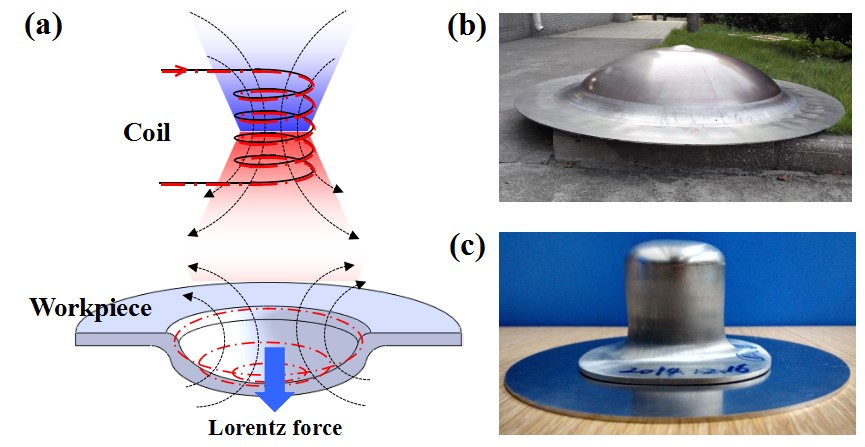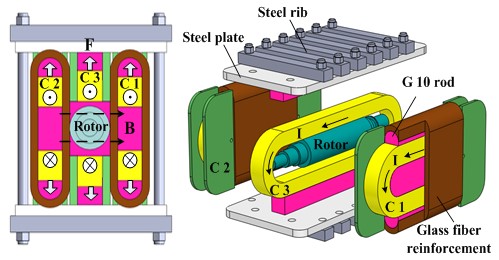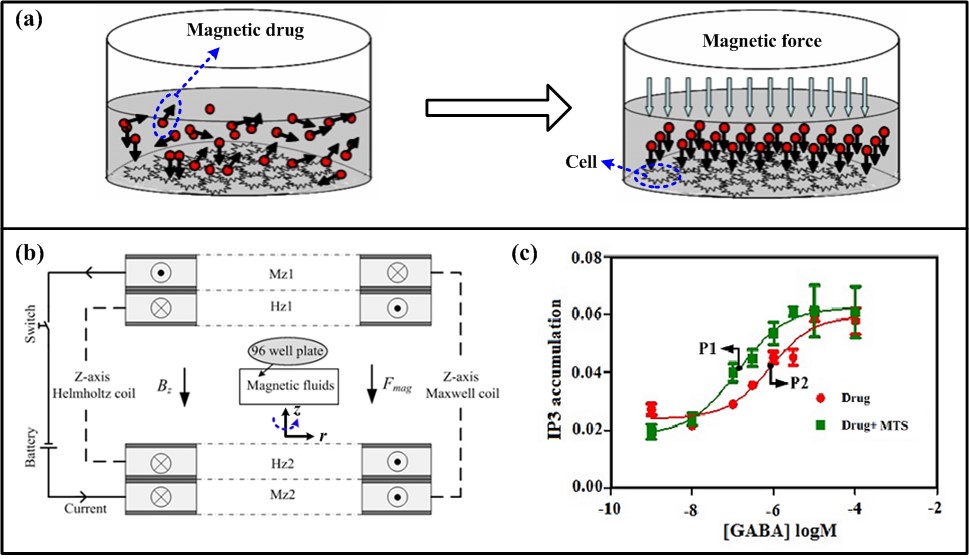Electrical Engneering
1. Electromagnetic forming
High-performance light-weight sheet and tube parts as well as their manufacturing technology occupies a pivotal position in the field of advanced manufacturing, which is an important safeguard of achieving light-weight equipment for enhanced performance, energy conservation and environmental protection. Light-weight materials, represented by Aluminum Alloy, have a poor forming performance using the traditional quasi-static stamping process, such as easy fracture, large springback and poor surface quality. Electromagnetic forming with features of high-speed, non-contact and single-die is considered to be one of the most promising methods to solve these problems. However, the pulsed electromagnetic forces are not strong enough and hard to be adjusted in the existing EMF systems due to single-coil and single-power model, which has restricted its extensive applications in forming large-scale and complex sheet.
To solve the current bottleneck problems of the EMF technology, a Space-Time-Controlled Multi-Stage Pulsed Magnetic Field (Stic-Must-PMF) forming and manufacturing technology has been proposed at the WHMFC. Stronger electromagnetic forces can be generated by introducing the nondestructive pulsed high field magnet technology to fabricate tool coils with high strength and long life performance. Meanwhile, the distribution of these forces acting on the workpiece can be well adjusted by using multiple tool coils and several sets of pulsed power systems, in which each coil is energized individually by its associated power supply with precise timing control. To validate the effectiveness of this improved EMF technology, a three-stage forming system with three types of pulsed power supply and a timing control system has been developed at the WHMFC, and serials studies have been carried out for large-scale sheet forming, deep drawing of sheet metal as well as tube forming.

Fig. 1. (a) Schematic diagram of an electromagnetic forming process. (b) A large-scale aluminium alloy part. (c) A deep-drawn part.
2. Post-assembly magnetization
Permanent magnet (PM) motors are widely used thanks to their outstanding advantage of high efficiency and energy saving. The permanent magnets are usually pre-magnetized and then assembled on the motors. The pre-magnetized magnets should be handled with great care during the assembly process to prevent them from damage or causing injury because of the very strong attractive or repulsive magnetic force. One effective solution for this problem is to magnetize the permanent magnets after the rotor is assembled or the motor is completely assembled. Post-assembly magnetization not only simplifies the assembly process, reduces the cost, but also improves the performance of the motor.
One common method for post-assembly magnetization is to magnetize the permanent magnets by a pulse of high current through the stator winding after complete assembly. But this method mainly aimed at small motors due to the magnetizing current is prohibited by the stator windings. We focused on magnetizing the motor by a specially designed magnetizing fixture or by integrated magnetizing windings. For the rotor of a 100 kW high speed PM motor, a magnetizing fixture consisting of three magnetizing coils was specially designed. The rotor has an outer diameter of 80 mm and total length of 515 mm, among which the pole length is 285 mm. It is designed as a two-pole rotor with parallel magnetization. The magnetizing fixture energized by two 1MJ capacitor bank modules can produce peak field of 6 T to fully magnetize the assembled rotor. For the surface mounted and insert type PM motors, the magnetizing windings are directly wound on the outer surface of the permanent magnet, and then assembled on the motor. The PM poles can be magnetized and demagnetized after assembly by the integrated magnetizing windings. Once the PM poles experienced demagnetization fault, the magnetizing windings can magnetize the PM poles again without disassemble of the motor. The integrated magnetizing windings of a 2 MW PM wind generator and a 20 kW PM synchronous motor were designed. The magnetizing test revealed that the PM poles can be successfully magnetized and demagnetized by the magnetizing winding.

Fig. 2. Schematic diagram of the post-assembly magnetization system for a 100 kW high speed permanent magnet rotor
3. Magnetic manipulation
Manipulation of particle motion using magnetic fields is an effective technique for transport and localization of micro-and nanomaterial. Due to several advantages including multifunctionality, targetablity, controllability and noncontact, the technique has attracted growing interest in various biological and chemical applications such as drug targeting for medical treatment, gene delivery and particle separation.
Based on this technology, several numerical and experimental studies have been carried out at the WHMFC, including magnetic drug delivery, magnetic separation and mixing in microfluidics. For example, we have adapted the principle of magnetic manipulation in the activation process of G protein-coupled receptor (GPCR). In the conventional activation process, the activation efficiency of GPCR is relatively low due to insufficient contact of drug with target cells. To solve this problem, a gradient magnetic field generated by an electromagnetic system has been applied to produce magnetic force for delivering the drugs carrying magnetic nanoparticles to the bottom of the plate. Then the drug concentration around the cell-surface receptors can be greatly improved. Experimental results have shown that the activation efficiency of GPCR can be increased about 6 times with the aid of the principle of magnetic manipulation.

Fig. 3. (a) Schematic illustration of drug and cell distribution in the plate with and without magnetic field. (b) Schematic diagram of the magnetic targeting system for enhancement of the activation efficiency of G protein-coupled receptor. (c) Concentration-response curves for GABA and GABA with MP generated from the IP formation assay on wild type GABAB receptor under the action of gradient magnetic field. MTS represents “magnetic targeting system”.


